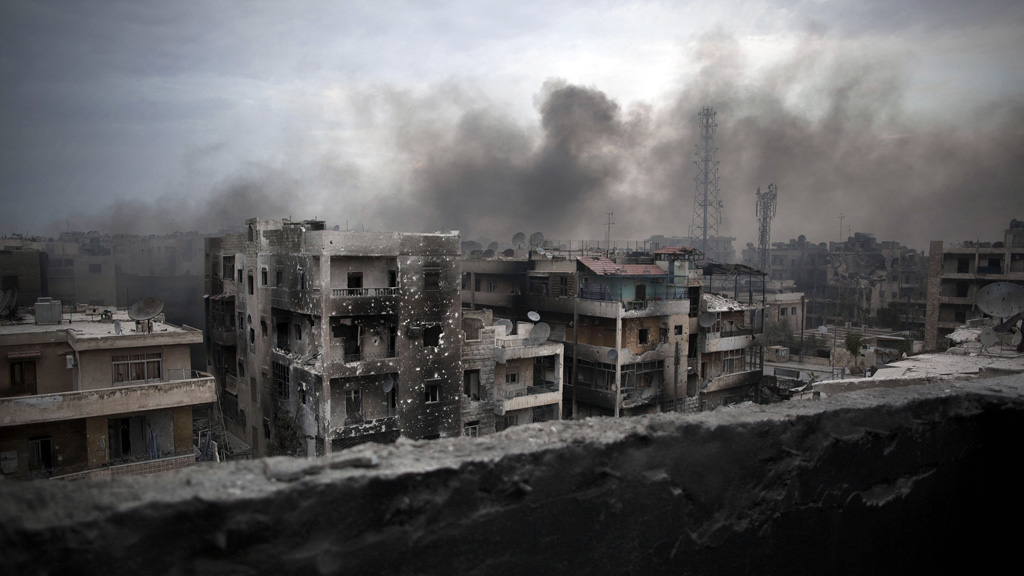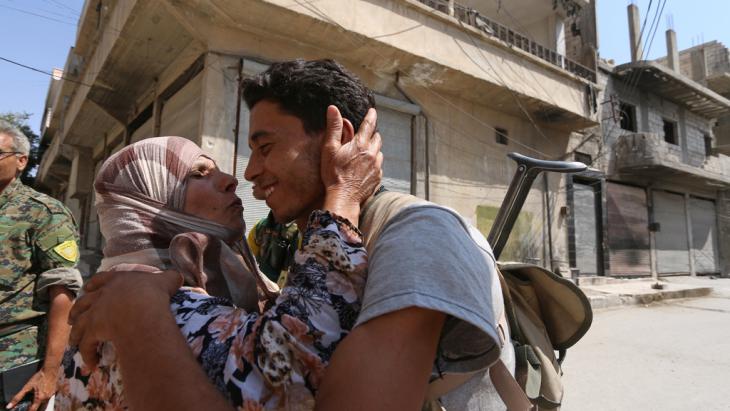Seven levels of hell

″If the regime recaptures Aleppo, civilians will be history,″ the Syrian blogger Marcell Shehwaro said back in November 2014. An estimated 200,000 people have been trapped in eastern Aleppo since the beginning of July 2016. With the help of the Kurdish PYD (Democratic Union Party), the Assad regime gained control of the last access road, the Castello Road. At the same time, the regime and its allies have intensified air strikes on Aleppo itself and on the surrounding area. This includes towns such as Atareb, which has seen unprecedented levels of bombardment for several weeks now.
Russia denies any responsibility whatsoever for the dramatic worsening of the situation. The Russian deputy minister for foreign affairs, Sergey Ryabkov, stated on 3 August that Russia’s involvement in Aleppo was purely humanitarian: ″We have no goals other than solving humanitarian problems faced by the residents of Aleppo and creating conditions to extend the ceasefire,″ he said. He rejected all speculation about an offensive against Aleppo by either the regime or the Russian Air Force, calling this ″absolutely false and harmful interpretations of our actions″.
A ″Terminator″ for relief operations?
A few days earlier a helicopter had been shot down which, according to Russian sources, was just delivering humanitarian aid. The Syria expert Michael Weiss responded by asking why Russia had sent the ″Terminator″ to deliver humanitarian aid, since on closer inspection the helicopter seems to have been extremely well equipped for an attack, whereas it was not immediately apparent how it could have been used for relief flights.

It is a characteristic of the war in Syria that obvious facts are being brazenly denied, primarily by Russia and the regime. Thus, after thousands of barrel bombs had been dropped and Bashar al-Assad’s own defence minister had bragged on state television about the invention of this ″inexpensive weapon″, the Syrian president still went on to claim: ″There’s no barrel bombs. We don’t have barrels.″
Given the quality of such propaganda, it makes no difference if it is tangled up in contradiction. Because if there is no offensive against Aleppo, why would Putin and Assad open the humanitarian escape corridors out of Aleppo, as they announced that they would?
There is no doubt that the regime and its allies are targeting civilians and the civilian infrastructure, and hospitals in particular. Ever since the start of the conflict, doctors who treat injured supporters of the opposition have had to fear for their lives. In early June 2016 nine new-born babies narrowly escaped death when they had to be taken out of incubators during an airstrike on the hospital. There are only 18 incubators left in Eastern Aleppo. In other wars it is customary to pass on the co-ordinates of hospitals to ensure that they are not hit unintentionally. Doctors Without Borders are now refusing to pass on data about the healthcare facilities they work with in Syria – because the regime is deliberately targeting them.
″There are still six ambulances,″ we are told in an article by SWR correspondent Martin Durm on the situation in Aleppo. ″But the rescue teams now prefer to transport the wounded on three-wheeled pickup trucks. They’re harder for snipers to hit, and more manoeuvrable in the alleyways.″
Eye-witnesses in both in the east of the city and the surrounding area have all testified that no roads are open. Supposedly, hundreds of refugees have got out, but they have not turned up anywhere else: no one, neither the UN nor any of the NGOs, has heard anything of them.
The barrel bombs are a fact. The humanitarian corridors, so far, are fiction. Three were supposedly being established for civilians, with another to the north for fighters. Russian and state media reported that several hundred civilians had left the city by these routes and been housed in emergency shelters. There has been no confirmation of this from within Aleppo itself. ″As far as I am aware, none of these corridors exist,″ says the political analyst Haid Haid. ″But even if they do, it’s hard to imagine anyone using them. Nobody trusts the regime. What happened in Homs weighs heavy on their minds.”
In January 2014 the regime agreed to grant safe conduct to civilians and fighters in the centre of Homs – overseen by the UN. Empty promises. Hundreds of men were arrested; some were sent to the front, and around 200 have disappeared without trace.
No safe areas[embed:render:embedded:node:14411]
So no matter how hopeless the situation became in certain places, there are many for whom laying down their weapons was not an option. If you keep on fighting, you still have a chance of survival, they said; if you give up, you’re effectively signing your own death warrant. For many civilians the situation was clear: they may not like all of the different fighting groups, but without them they would be entirely devoid of protection, at the mercy of the regime.
There is also the purely practical question of where the citizens of Aleppo would flee to in order to reach safety. There are no safe areas around Aleppo. The neighbouring states are not taking any more refugees, and it is increasingly difficult for refugees to pass between regime- and rebel-held territory. Safe passage out of Aleppo is therefore still no guarantee for what could happen to refugees afterwards.
The UN special envoy for Syria, Staffan de Mistura, is aware that it is very problematic to set up humanitarian corridors controlled by of one of the warring parties. He is calling for the UN to be put in charge of supervising the evacuation of the city.
Subjugation or death
And this goes to the heart of the problem with Western policy in Syria. Western states have long since stopped aspiring to resolve the fundamental problem: Bashar al-Assad’s hold on power, to which he is clinging, and for which he is also prepared to commit genocide.
The regime is seeking to assert its own interests at the expense of the civilian population rather than through political negotiation. And the international community, anxious to avoid becoming directly involved, is playing along. Instead of making serious demands for civilians to be protected according to the Geneva Convention, it contents itself with demands for the alleviation of their suffering – although, like the humanitarian corridor under UN control, these demands are merely symbolic.
A demand for UN-supervised humanitarian corridors cannot be anything other than symbolic when the UN itself has said it can’t even run a monitoring team for a ceasefire. Without a robust mandate the UN cannot issue any guarantees whatsoever that those fleeing will not be harmed.
It is unrealistic to think that Russia would approve such a mandate. It is, after all, backing the regime’s strategy of ″subjugation or death″, which only the Russian air strikes make possible.
Bente Scheller
© Qantara.de 2016
Translated from the German by Charlotte Collins